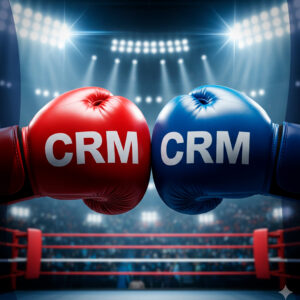
December Business Playbook: Retain Clients & Boost Revenue
Prepare Your Business for Q1 2026 December is not just
By Jean-Charles Spanelis- 10 November 2023
Customer acquisition is at the heart of every thriving business. But how much does it really cost you to acquire a new customer? And more importantly, are you spending each euro wisely?
📊 Let’s Examine the Costs: It’s essential to understand where every penny of your acquisition budget is going. This allows you to spot unnecessary expenses and optimize your return on investment.
🎯 Tips for Effective Customer Acquisition:

In today’s competitive landscape, it’s not enough to set up a customer acquisition strategy and hope for the best. To ensure success and return on investment, it’s essential to regularly analyze your efforts and adjust them accordingly. Here’s why and how.
Measuring to understand: Without concrete data, it’s impossible to know what works and what doesn’t. Analysis tools provide you with valuable information that can help you understand where your budget is going and what return you are getting. Informed decision-making: The data collected through analysis allows you to make decisions based on real facts rather than assumptions or intuitions.
There are numerous analysis tools on the market, from web analytics platforms like Google Analytics to customer acquisition-specific tools like HubSpot or Salesforce. These tools can help you track: Customer acquisition cost (CAC) Advertising return on investment (ROAS) Conversion rate Lead source And many other key performance indicators (KPIs). An Excel file and/or a CRM including all your lead qualification criteria can be very useful, especially at a time when your differentiation will come from the ability of your teams (soft skills) to analyze and inform these tools (hard skills) of their judgments and their recommendations.
Once you have a clear idea of your performance, it’s time to adjust your strategy. Identify the most effective channels: If you find that certain lead sources have a much higher conversion rate than others, it may be wise to increase your investments in these channels. Eliminate or modify underperforming tactics: If some of your advertising campaigns or marketing tactics are not yielding the expected results, it may be time to rethink or eliminate them. Test new approaches: Analysis can also reveal opportunities you hadn’t considered. Perhaps a new advertising platform is emerging or a specific market segment is showing increased interest in your product. Staying alert, listening, and working with specific partners in total agility has probably become more necessary than ever to remain competitive.
In the business world, competition is fierce. To stay ahead, it’s not enough to have an excellent product or service; it’s just as crucial to have a competent and well-trained sales team. Investing in your sales team’s continuous training can make all the difference. Here’s why.
Adaptability to the market: The business world is rapidly evolving. New technologies emerge, market trends change, and customer expectations increase. Regular training ensures that your team stays up-to-date and can adapt to these changes. Skill Improvement: Even the best salespeople can benefit from a skills upgrade. Continuous training offers the opportunity to deepen existing skills and develop new ones.
Increased conversion rate: A well-trained sales team better understands the needs of customers and knows how to present your product or service to maximize conversions. Customer loyalty: Trained salespeople do more than close sales; they build relationships. This can lead to greater customer loyalty and repeat sales. Reduced turnover rate: Investing in training shows your team that you care about their professional development. This can increase job satisfaction and reduce turnover.
Needs Assessment: Before setting up a training program, assess the needs of your team. Where are their gaps? What skills could be improved? Diversify Training Methods: Combine in-person workshops, online training, individual coaching, and other methods to meet the varied needs of your team. Measure Results: After each training session, evaluate its effectiveness and always organize feedback sessions both with the individuals trained and with their Management in order to have real collaborative progress over time. Has it led to an increase in sales or at least, for more complex solutions, to a better ability to sell or to an improvement in skills?
Investing in your sales team’s continuous training is an investment in the future success of your business. At Finelis Coaching, we understand the importance of a well-trained team and are here to help you set up effective training programs. Contact us to find out how we can help you strengthen your sales team’s skills.
In the business world, stagnation often equates to a setback. Sticking to a single strategy, even if it has worked in the past, may not be enough to guarantee future success. Diversification and experimentation are essential to ensure that your business remains competitive. And it is often the entrepreneurs themselves who will develop this type of competence… are you really hiring entrepreneurial profiles? Here’s why diversification and experimentation are essential.
Markets, technologies, and consumer behaviors are constantly evolving. What works today may not work tomorrow. By testing different strategies, you can stay agile and adaptable. Risk reduction: Putting all your eggs in one basket can be risky. If that single strategy fails, it can have disastrous consequences for your business. Diversification allows you to spread the risk.
By testing different approaches, you might discover new market opportunities or new methods for reaching your customers. Optimizing resources: By identifying the most effective strategies, you can allocate more resources to what works and reduce or eliminate what doesn’t. Continuous improvement: Experimentation leads to innovation. By constantly seeking to improve and adjust your strategies, you can stay at the forefront of your industry.
Set clear goals: Before you start experimenting, define what you hope to accomplish. This will give you a basis for measuring success. Measure and analyze: Use analysis tools to track the performance of each strategy. This will allow you to see what works and what doesn’t. Be ready to pivot: If something isn’t working, don’t be too attached. Change your habits and accept a failure or an initiative that didn’t bear the expected fruits and learn from it for the future. Be ready to change course if necessary.
Diversification and experimentation are not just buzzwords; they are essential elements of a successful business strategy.
At Finelis Coaching, we are experts in helping businesses test and optimize their strategies. Contact us to find out how we can help you diversify your approaches and maximize your success.

The commercial success of a business does not rely on a single strategy or approach. It requires a combination of in-depth analysis, continuous training, experimentation, and adaptability. In a constantly evolving business world, it’s essential to stay agile, invest in the development of your team, and not hesitate to explore new avenues.
At Finelis Coaching, we understand the importance of each of these elements and are determined to help you navigate this complex landscape.
If you’re ready to optimize your customer acquisition strategy and propel your business to new heights, don’t wait!

Prepare Your Business for Q1 2026 December is not just

Between strategy, leadership, and delegation, learn how CEOs can transform their overwhelming to-do lists into powerful instruments of business clarity.

Understanding your website visitors means unlocking insights to sharpen your sales strategy, personalize outreach, and drive measurable results.

Lead generation is no longer about quantity but quality. In 2025, success comes from targeting the right prospects and guiding them with trust and care.

There is no absolute winner in the CRM battle. The right CRM is the one that matches your goals, teams and sales maturity.

Leadership can be isolating. Executive coaching provides support, perspective, and tools to help leaders make confident and effective decisions.